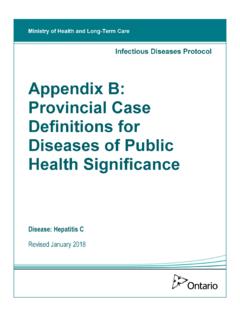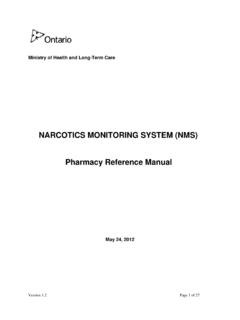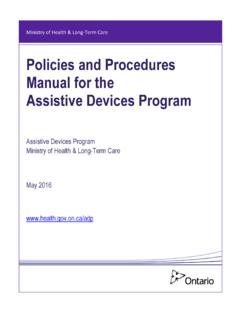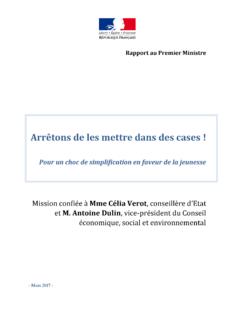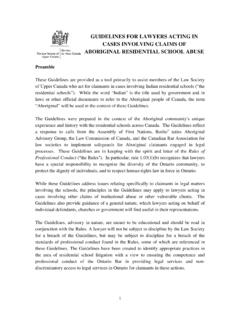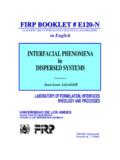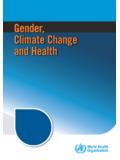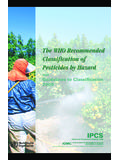Transcription of Appendix A: Disease-Specific Chapters
1 Ministry of Health and Long-Term Care Infectious Diseases Protocol Appendix A: Disease-Specific Chapters Chapter: Hepatitis A Revised March 2017 Health and Long-Term Care Hepatitis A Communicable Virulent Health Protection and Promotion Act: Ontario Regulation 558/91 Specification of Communicable Diseases Health Protection and Promotion Act: Ontario Regulation 559/91 Specification of Reportable Diseases Aetiologic Agent Hepatitis A infection is caused by the hepatitis A virus (HAV), a 27-nanometer picornavirus, positive-strand RNA virus. It has been classified as a member of the family Case Definition Surveillance Case Definition See Appendix B Outbreak Case Definition Outbreak case definitions are established to reflect the disease and circumstances of the outbreak under investigation.
2 For example, confirmed outbreak cases must at a minimum, meet the criteria specified for the provincial surveillance confirmed case classification. Consideration should also be given to the following when establishing outbreak case definitions: Clinical and/or epidemiological criteria; The time frame for occurrence ( increase in endemic rate); A geographic location(s) or place(s) where cases live or became ill/exposed; Special attributes of cases ( , age, underlying conditions); and Further strain characterization and typing as appropriate, which may be used to support linkage. Outbreak cases may be classified by levels of probability ( , confirmed, probable and/or suspect).
3 2 Health and Long-Term Care Identification Clinical Presentation Typically, hepatitis A is an acute, self-limiting liver infection. Clinical presentation varies with age of Infection is usually asymptomatic or inapparent in children, and jaundice develops in < 10% of children 6 years and Adults are typically symptomatic, with more severe disease. Symptoms may range from mild flu-like illness; to 1 to 2 weeks of mild, self-limited disease with jaundice; to fulminant hepatitis. Typically, acute clinical illness is characterized by a 1 to 7 day prodrome of abrupt onset fever, malaise, anorexia, nausea and abdominal pain followed by , 2 Dark urine and light-coloured stools, as well as pruritis may occur, and an enlarged liver may be seen.
4 Extra-hepatic complications may It has been reported that between 3% and 20% of cases may experience relapsing Fulminant hepatitis and death are rare. There is usually complete recovery without complications or Chronic infection is not known to occur. Diagnosis See Appendix B for diagnostic criteria relevant to the Case Definition. Note: Serology tests indicating IgM anti-HAV antibodies confirms recent infection. Antibodies are generally detectable in serum 5-10 days after infection and usually decrease to undetectable levels within 6 months after onset of , 5 In rare cases, they may persist for longer. For further information about human diagnostic testing, contact the Public Health Ontario Laboratories or refer to the Public Health Ontario Laboratory Services webpage: Epidemiology Occurrence Worldwide, sporadic and epidemic.
5 In endemic areas, adults are usually immune. In Ontario, hepatitis A occurs throughout the year with no clear seasonal pattern. Between 2007 and 2011, an average of 120 cases were reported annually. The disease is most common among school-aged children and young adults. Please refer to the Public Health Ontario Monthly Infectious Diseases Surveillance Reports and other infectious diseases reports for more information on disease trends in , 7 3 Health and Long-Term Care Reservoir Humans; rarely chimpanzees and other Modes of Transmission HAV infection is transmitted primarily by the fecal-oral route, through direct contact with infected people or indirectly through ingestion of contaminated water or foods ( seafood harvested from contaminated water).
6 1 Fecal-oral transmission has been reported as the mode of transmission in outbreaks associated with daycare center employees or In recent years, contaminated produce (such as green onions, blueberries, frozen strawberries, sun dried tomatoes, salad and lettuce) along with oysters and orange juice, have been associated with community-wide outbreaks (see additional resources). On rare occasions, transmission has been reported after exposure to HAV-contaminated blood or blood products obtained from viremic donors during the incubation period of their Transmission may also occur through sexual activities that include direct or indirect oral-anal contact but not through exposure to saliva, semen or For example, several outbreaks have been associated with injecting and non-injecting drug use and men with multiple male sex Transmission from mother to newborn infant (that is, vertical transmission)
7 Is The virus may persist for days or weeks in the Incubation Period The incubation period ranges from 15 to 50 days with an average of 28 to 30 Period of Communicability Maximum communicability occurs during the latter part of the incubation period with peak levels in the 2 weeks before clinical illness. Communicability diminishes rapidly thereafter and ends shortly after the onset of Cases are considered non-infe ctious 7 days after onset of jaundice although prolonged viral excretion up to 6 months has been documented in infants and Chronic shedding of HAV in feces does not Host Susceptibility and Resistance Seroprevalence of hepatitis A virus (HAV) antibody (indicating protection from natural infection or previous vaccination)
8 Has been assessed nationally by several studies and has been shown to increase with increasing age reflecting secular trends in the HAV transmission Amo ng t hose aged 14-19 years, it was estimated at , rising to among those 60-79 HAV seroprevalence in Canadian children 4 Health and Long-Term Care aged 8-13 years residing within Canadian provinces was found to be only 2-3% in this age group, demonstrating the extent of this age group's Immunity following natural infection is thought to be life-long (1). Protective antibody levels following vaccination will persist for at least 20 years or longer and protection likely persists even when antibodies are no longer measurable due to immune The risk of hepatitis A infection for non-immune travellers to developing countries had been estimated to be as high as 1 to 5/1,000 per month, cases in males being times higher than in females.
9 More recent data on Swiss travellers suggest that the risks of acquiring hepatitis A infection have markedly decreased over the last 10 to 15 years, with more recent estimates of to 1/1,000 per month. This still represents a significant risk of illness. In addition, the risk may be much higher for low-budget travellers, volunteer humanitarian workers and immigrants visiting friends and relatives in their homelands, who may be eating in settings with poor Reporting Requirements To local Board of Health Individuals who have or may have HAV infection shall be reported as soon as possible the medical officer of health by persons required to do so under the Health Protection and Promotion Act, 1990 (HPPA).
10 12 To the Ministry of Health and Long-Term Care (the ministry) or Public Health Ontario (PHO), as specified by the ministry Report only case classifications specified in the case definition using the integrated Public Health Information System (iPHIS), or any other method specified by the ministry within one (1) business day of receipt of initial notification as per iPHIS Bulletin Number 17: Timely Entry of The minimum data elements to be reported for each case are specified in the following: Ontario Regulation 569 (Reports) under the Health Protection and Promotion Act (HPPA);14, 13 The iPHIS User Guides published by PHO; and, Bulletins and directives issued by PHO. Prevention and Control Measures Personal Prevention Measures Proper personal hygiene and hand washing hygiene are key to prevent transmission.

